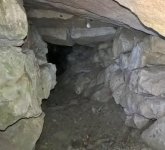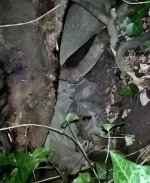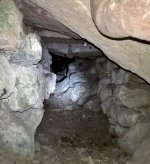A book that mentions the climb up to the holes about 15 feet below the top of the crags is Nunn, Paul, 1975. Rock Climbing in the Peak District. 304pp The climb is called the Gangue Grooves (gangue = vein mineral).
Originally, there was not a gap in the cliffs between Harp Edge and the Willersley Crags, it was a continuous ridge. The Harp Edge pipes weaken eastwardly, the most extensive workings being behind about the Scarthin Bookshop area. A reference I found only recently indicates that the main entrances were a series of cave-like openings in the hillside there, now hidden underneath the houses.
There was a legal case concerning the workings in Scarthin Rocks - a level behind the millyard was described as a "wind gate" and it was stated that Arkwright had had the shafts on top of the tor filled in with ashes, which at least would be easy to dig out. Perhaps they used ashes because they would be lighter to carry up there - no mine refuse would be available because the miners just dumped it down the cliff face. The miners used to have iron pegs up the cliff face to allow them to climb up to the entrances. I had assumed that the obvious entrance behind the mill yard was the wind gate but there may have been others - I do not recognise the photos shown by Rob87.
As regards the query about my book, although it sounds daft after so many years, I have had a major research blitz this last year that has brought in much new info' but when I have finished adding it all in and smoothing the text over, I shall have to think about publication again. I was talking this over with Jim Rieuwerts a couple of days ago because he has had works published privately, and they looked very good to me.
There have been postings about Harp Edge Pipes in the past. I have pointed out that the main shaft, c120 feet deep, was open in 1970 and may just be capped and covered over.





